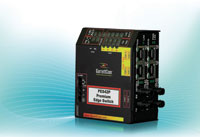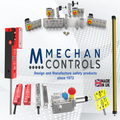
Posted to News on 26th Oct 2012, 00:00
The power and the glory
The speed at which Power over Ethernet (PoE) has become a prevalent technology in many areas of industry is astonishing. And yet perhaps it is not surprising, since it allows users to finally benefit from ultimate flexibility for the installation of powered equipment. John Ward of GarrettCom Europe explains.

>Picture the scene; you've toiled long and hard working out how best to install networked devices in some hard-to-reach location, only to discover an unanticipated problem that makes it is either not cost effective or too arduous to provide power. How many times must that have happened? Well, it need be a problem no longer, because with Power over Ethernet (PoE), the same cable that carries the data to and from the connected equipment can also carry the power.
>The acceptance of PoE means both suppliers and users of industrial Ethernet products have a beneficial technology for a multitude of different application environments such as utilities, substations, mines and quarries, transportation systems, factory facilities, and warehouses.
>Concentrating for a moment on the "Power" aspect of PoE, this technology represents the only truly universal power standard. Whilst there are differences in the mains plugs in the UK to those used worldwide, the RJ45 connection and voltage output of PoE are standard the world over. Indeed, when you think about the multitude of electronic devices that require a DC input but consume, say, 15-30W of power; it is not difficult to foresee a time when a PoE standard is one of the world's most popular sources of power.
>The potential for PoE, then, is enormous, and need not be limited to the harsh environments of the industrial marketplace. One electronics company has manufactured a PoE electric razor. Obviously it does not require data transfer, but it gets the power it needs, and will certainly help to demonstrate the versatility of POE. Today there are many different types of device which are PoE enabled including:
>
- Wireless access-points
- VoIP phones
- Industrial devices (sensors, controllers, meters etc.)
- Access control (Intercoms, Entry cards, Keyless entry, etc.)
- Help-points (Intercoms etc.)
- Lighting controllers
- Remote Point of Sale (POS) kiosks
- Security Cameras
>This is by no means an exhaustive list; and provided more power can be supplied, over the next few years it is likely that PoE will rise to become the power source of choice for devices such as: smoke/fire detectors, RFID scanners, Audio/Video jukeboxes, vending/gaming machines and even chargers/docking stations for PDAs and mobile phones.
>Thus, Power over Ethernet has become one of the hottest topics in twenty first century technology. As trends in Voice over Internet Protocol (VoIP), 802.11 Wireless Local Area Networks (WLAN), and Video over IP accelerate, the numerous benefits provided by PoE can help turn good ideas into practical applications. These benefits include:
>
- Easier deployment - Access to hard-to-reach locations or places with a lack of space for power deployment, such as roadside, external walls and internal ceilings, becomes much simpler and easier to maintain.
- Lower cost - Costs can quickly escalate when the installation of separate power outlets are factored into a project. PoE switches save both time and money by avoiding the need for separate installation of Power outlets. Centralised power redundancy further helps to save money by reducing the need for backup power to each critical device.
- Multi-location - Wherever there is an Ethernet connection, a powered device can be used.
- Increased uptime/improved reliability - If an Uninterruptable Power Supply (UPS) is used in the power supply for the PoE switch, reliability rises towards the optimum "five nines" due to reliance not being placed on the mains supply.
- Plug and Play - Equipping applications with PoE switches is simple and enables interoperability with a growing variety of devices.
- Scalable deployment - Non POE equipment can be deployed and upgraded at a later date to be POE (using POE injectors) when budgets allow or the need arises.
>PoE technology
>The PoE standardisation project began in 1999, and in 2003 the Institute of Electrical and Electronics Engineers (IEEE) task force ratified the technology into the Ethernet standard 802.3af. The IEEE 802.3af standard - also referred to as Data Terminal Equipment (DTE) Power via Media Dependent Interface (MDI) - was the first international standard to define the transmission of POE infrastructure.
>The mechanism for delivering power via PoE is similar to the way in which the PSTN (Public Switched Telephone Network) carries enough power to every public telephone handset. Power is injected into the Ethernet cable along with data by Power Sourcing Equipment (PSE). The Powered Device (PD) receives power and data over the Ethernet cabling.
>The 802.3af standard requires that a PSE probes the end device to determine whether or not it is a PD and, if so, what its capability is. The 802.3af standard ensures the safety of PDs by making a 25kΩ resistor in the PD mandatory. Power is applied only when the "discovery process" running from the PSE detects the resistor. This prevents damage from occurring to non-PD devices. In addition, the PoE standard calls for over-current protection, under-current detection, and fault protection of PDs from shorts, power fluctuation or failure.
>The PSE will typically be an Endspan device (Mode A) - an Ethernet switch or router supporting PoE. Midspan (Mode B) operation is also possible, but typically these do not verify whether the end device is capable of being powered through PoE. The PD is a PoE-enabled terminal such as an IP phone. PoE systems are deployed in a "star topology", so each PD is connected to a separate channel of the central PSE.
>The PoE standard allows use with 10Base-T and 100Base-TX, which use only two of the four pairs in the cable, but also with 1000Base-T (gigabit Ethernet), which uses all four pairs for data transmission. This is possible because all versions of the Ethernet over twisted pair cable specify differential data transmission over each pair with transformer coupling.
>When the IEEE task force began its work on PoE, CAT3 cabling was the prevalent standard. The current carrying capacity of the cable was a key limiting factor in available power, which was specified at a maximum of 15.4W per cable at the source, with devices allowed to use no more than 12.95W to allow for degradation of power over the cable length. Voltage range was set between 44V and 57V DC (with 37-57V available at the PD), with current ranging from a minimum of 10mA to a maximum of 350mA.
>The IEEE 802.3af specification uses a physical layer power classification method at device start up, based on five PD classes which specify the maximum power level output at the PSE.
>
- Class 0: 15.4W (default)
- Class 1: 4W
- Class 2: 7W
- Class 3: 15.4W
- Class 4: reserved for future use
>Class 4 was interesting in that it predicted later developments. This came in 2009 when PoE+ was ratified under the IEEE 802.3at specification. The driving force behind this updated standard was the higher power required by new generations of PDs, and was enabled by industry's growing standardisation on CAT5 cabling. With its reduced cable resistance, CAT5 enables significantly higher current to be carried without the risk of overheating. Power was thus raised to 34.2W at the PSE, 25.5W at the PD, with currents up to 600mA. Voltage was raised to 50-57V (42.5-57V at the PD).
>There are other benefits of PoE+ as well. In particular, it differs from PoE by allowing two PD interfaces on a single RJ45 connector, with one operating in Mode A and the other in Mode B. This opens up a higher degree of flexibility in installations - as long as the limitations of Mode B are understood in terms of its ability to determine whether the PD is capable of accepting Power over Ethernet.
>The IEEE 802.3at specification uses the same five classes of power levels, but now defines Class 4 as high power, offering 12.95 to 25.5W at the PD, 34W at the PSE. This 25.5W is ample to power the vast majority of today's higher powered typical 'edge of network' devices, but the race is on to see just who can squeeze the most power out of a PoE cable. Manufacturers are already claiming 60W, and some say they can push this even higher, although these products would not conform to the 802.3at specification. The limiting factor is not the PSE (these devices will happily supply more power), but the CAT5 cable as it cannot support higher power throughputs. To overcome this problem you would have to use a higher category rated cable, such as CAT6.
>But the drive to squeeze ever more current at higher voltages down an Ethernet connection is something of a red herring when it comes to developments in and implementations of PoE. Instead, much of today's focus is on making the most of the flexibility offered by PoE, and in many instances what that comes down to is having industrially hardened PSEs that meet the performance requirements (as distinct from the power requirements) of the PDs.
>GarrettCom can lay claim to developing the first truly industrially hardened PoE switch. Of course that's a nice thing to be able to say, but the timescale is significant. In the past, it has taken 10 years or longer for enterprise-based Ethernet technologies to be adapted for use in industrial applications. But with PoE, the first industrial products were arriving on the market within 18 months or so.
>Industrial Ethernet takes Ethernet onto the factory floor, down mines, out onto city streets, into mobile applications, into conflict zones and other challenging environments. Users rely on 'plug and play' installation simplicity, and a degree of ruggedness unheard of in typical IT applications. Best of breed industrial Ethernet switches are hardened to offer extended temperature operation from -50°C to +95°C. They offer absolute EMI/RFI interference rejection and protection as standard, and can be conformally coated for protection against high humidity, corrosive chemicals and salt spray. Rugged, robust, and without the need for internal cooling fans, these highly reliable products offer dependable operation with impressive Mean Time Between Failures (MTBF) at extended temperatures.
>With modern, hardened PoE switches and a growing range of PDs, PoE is providing the ideal solution for applications where large data rates are involved and where flexible distribution of power is needed. In security PoE provides a scalable backbone not just for cameras but also for gate entry systems and access points, expanding options for optimal placement of the last wired link. It is finding growing uses in RF and infrared device applications, from barcode readers to RFID devices, tracking components, assemblies and people in industrial applications. The growing number of industrial sensors that are PoE enabled is simplifying installations on the factory floor, particularly with field devices at the edge of the network.
>Whilst we have yet to see specific safety-rated products on the market that are PoE enabled, there is no doubting that PoE is an inherently safe power technology. Maximum voltage is under the limit defined for high voltage applications. PSEs only supply power once the "discovery process" has identified the 25kΩ resistor in the PD, and if the PD stops using power, the power from the PSE is stopped and only started up again after a further successful discovery process. Add into that the current and fault protection built into the PoE standard, and we can see that a high degree of safety is assured.
>The prevalence of PoE power sourcing Ethernet switches for industrial Ethernet applications certainly enhances network design possibilities. They save money and space, as well as increasing both flexibility and reliability in a wide spectrum of applications. But does PoE have things all its own way? What about Universal Serial Bus (USB) connectivity which also supplies power, or the Ethernet over Power (EoP) technologies which are emerging in home networking environments?
>USB might seem a good option for an integrated power and data standard, but the typical PDs used in industrially-rated applications all require more power than USB can supply, and are very often installed and must be powered over longer cable runs that USB permits. Further, while PoE defines a single RJ45 connector, there are numerous types of USB connector, impacting on standardisation, flexibility and cost.
>EoP is certainly generating lots of interest in the home market, transmitting Ethernet data over mains cabling. But possible data rates are nowhere near what would be considered a bare minimum for demanding industrial applications, and one of the key attractions of PoE is the ability to deploy it anywhere around the globe without any concern for local variance in AC power supplies.
>PoE has other advantages over USB and EoP. CAT5 cabling is cheaper than USB repeaters, and there is no problem with meeting building code requirements as there is with running AC power cable. Also PoE can take direct injection of power from standard 48V DC batteries, which makes power backup strategies far easier to implement. Finally, symmetric distribution is possible, with the ability to supply power at either end of the cable or outlet, unlike with USB and AC outlets. This means the location of the power source can be determined much more flexibly, and more readily changed as the application evolves.
>PoE has one final trick up its sleeve. Just over the horizon is the tantalizing possibility of Power over Wireless Ethernet (PoWE), combining PoE with IEEE 802.11g wireless Ethernet. As yet this has not emerged from the laboratory, and even there it is still limited to microwatts of power. But developers are quickly pushing towards milliwatts, and that will be enough to begin to power many of today's PDs.
>Conclusion
>Since its introduction in 2003 as IEEE 802.3af, and its update in 2009 as IEEE 802.3at, PoE has made a major contribution to flexible, low cost, reliable industrial networking. Not only can PoE allow a whole host of network devices to be powered in remote locations where access to power is difficult, but it opens the door to a whole new world of exciting possibilities for consumer and business electrical products. It is almost certain that PoE will continue to drive major changes for industrial applications. Despite the available power in a PoE connected device being limited to 30W, the advantages of blending signal and power in one Ethernet cable connection will contribute to the already-rapid transition to Ethernet based industrial control systems.


















